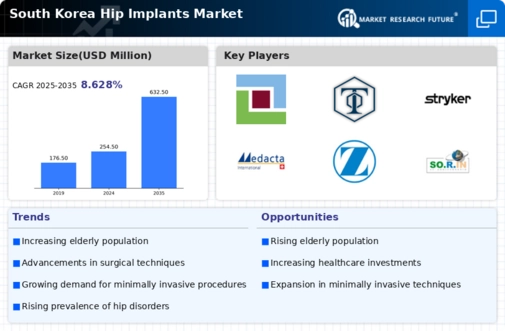Growing Healthcare Expenditure
The rising healthcare expenditure in South Korea is a significant driver for the hip implants market. With the government and private sectors investing heavily in healthcare infrastructure, the availability of advanced medical technologies is improving. In 2025, healthcare spending is projected to reach 9% of the GDP, reflecting a commitment to enhancing patient care. This increase in funding is likely to facilitate access to high-quality hip implants and surgical procedures, thereby expanding the market. The hip implants market stands to benefit from this trend, as more patients will be able to afford necessary surgeries. Additionally, the emphasis on preventive care and early intervention may further stimulate demand for hip implants, potentially leading to a market growth of around 10% over the next few years.
Rising Incidence of Hip Disorders
The increasing prevalence of hip disorders in South Korea is a crucial driver for the hip implants market. Conditions such as osteoarthritis and rheumatoid arthritis are becoming more common, particularly among the aging population. According to recent health statistics, approximately 30% of individuals over 65 years old experience some form of hip-related issues. This trend is likely to escalate the demand for hip implants, as patients seek surgical interventions to alleviate pain and restore mobility. The hip implants market is thus positioned to grow significantly, with projections indicating a potential increase in market size by 15% over the next five years. This rising incidence not only highlights the need for advanced surgical solutions but also emphasizes the importance of ongoing research and development in implant technologies.
Advancements in Surgical Techniques
Innovations in surgical techniques are transforming the landscape of the hip implants market. Minimally invasive procedures, such as arthroscopy, are gaining traction among orthopedic surgeons in South Korea. These techniques reduce recovery time and improve patient outcomes, making hip replacement surgeries more appealing. The hip implants market is witnessing a shift towards these advanced methodologies, which are expected to enhance the overall efficiency of surgical interventions. Furthermore, the integration of robotic-assisted surgery is anticipated to refine precision in implant placement, potentially reducing complications. As a result, the market could see a growth rate of approximately 12% annually, driven by the increasing adoption of these innovative surgical practices.
Increased Awareness of Joint Health
There is a growing awareness of joint health among the South Korean population, which is positively influencing the hip implants market. Educational campaigns and health initiatives are encouraging individuals to seek medical advice for hip-related issues earlier. This proactive approach is likely to lead to an increase in diagnoses and, consequently, a higher demand for hip implants. The hip implants market is expected to capitalize on this trend, as more patients recognize the importance of addressing joint health issues promptly. Furthermore, the collaboration between healthcare providers and community organizations to promote joint health awareness may result in a projected market growth of 8% in the coming years, as more individuals opt for surgical solutions to improve their quality of life.
Technological Integration in Healthcare
The integration of advanced technologies in healthcare is significantly impacting the hip implants market. Innovations such as 3D printing and personalized implants are becoming more prevalent in South Korea, allowing for tailored solutions that meet individual patient needs. This technological advancement not only enhances the effectiveness of hip implants but also improves patient satisfaction. The hip implants market is likely to experience substantial growth as these technologies become more accessible. Additionally, the use of digital platforms for patient education and follow-up care is expected to streamline the surgical process, potentially increasing the number of procedures performed. Projections suggest that the market could grow by 14% over the next five years, driven by the ongoing technological evolution in the healthcare sector.

















Leave a Comment